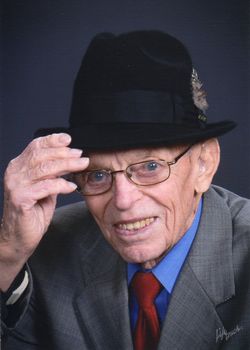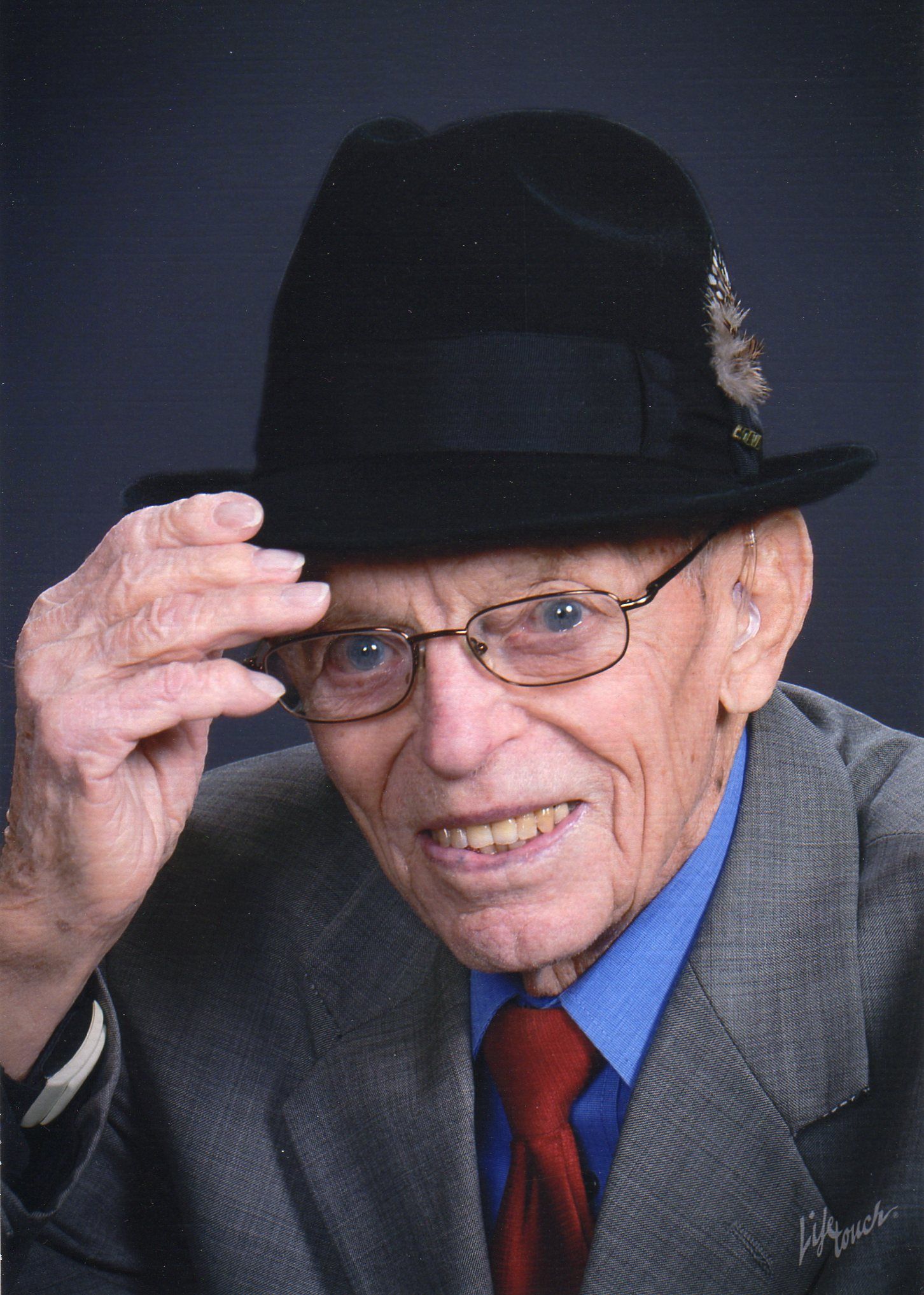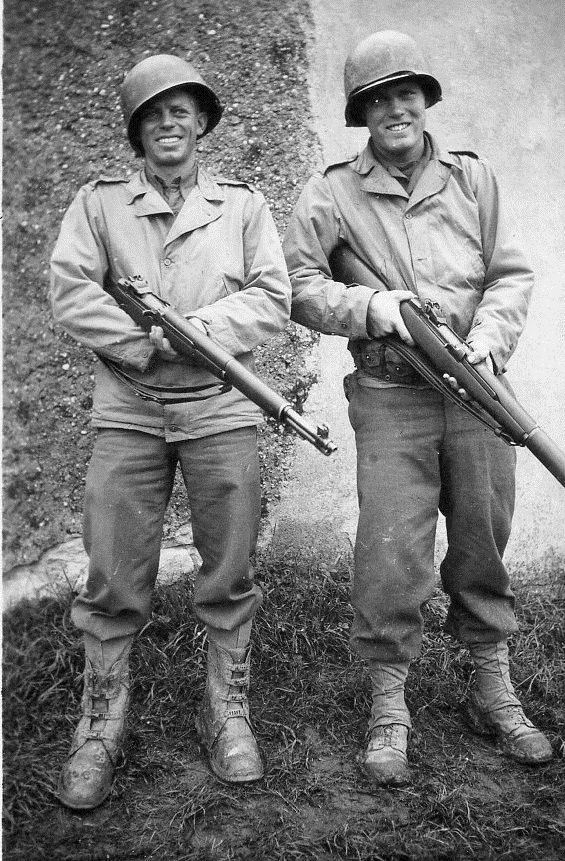Harold H. Heins was born August 5, 1915 on a farm near Garrison, to Jacob and Emma (Dallegge) Heins. He attended school through the 11th grade at Garrison and graduated from David City high school in 1932. In February of 1943 Harold enlisted in the United States Army. He served during WWII in the European Theatre in Unit 546, company C of the third Army. On December 10, 1940, he was united in marriage to Ruby From at the parsonage of St. John's Lutheran Church in Surprise, Nebraska. Harold farmed in the Garrison area and lived his entired life there.
Harold was a former Sunday school teacher, served on the church council, school board, soil conservation board, coop elevator and on the governor's advisory board.
Survived by Children: Larry (Jeanette) Heins of David City, Beverly (Richard) Bennett of David City, Patricia (Albert) Richert, Waco, NE, Dean (Connie) Heins of David City.
11 grandchildren, 6 step grandchildren, 39 great grandchildren.
Preceded in death by wife Ruby (Jan. 29, 1994), sister Mildred Anderson.
Faith Lutheran Church
Nebraska Lutheran High School, Waco
Hruska Library.
Kracl Funeral Chapel David City, in charge of arrangements."
Kracl Funeral Chapel, David City, Nebraska.
This was written by Harold Heins
Inducted Feb 2, 1942 Army Hdqg. In Omaha, went to Fort Dodge, Iowa was given aptitude tests and shots and divided up. A large group of us left by train for San Bernardino, Calf. near March Air Force Base. Camp Haan was our base but we never stayed there to long cause they had to make room for other men. We went out to the Desert Camp Irwin near Death Valley (still there today) and practiced our marches, practiced our shooting and how to set up our guns. This was actually worse than the war was.
We loaded out from Indio, Calif. On trains not knowing where we were going until the train started to head east. We arrived at Camp Shanks, NH April 14. Five days here, processed, took physical exams. Were loaded on trains and took to Ferry Station, crossed the Hudson River. Loaded on the largest ship afloat at that time, the Queen Elizabeth.
April 20, 1943 early in the morning towed out into the Atlantic by tug boats. We were the only antiaircraft battalion on the boat so we had to man the antiaircraft guns.
We had no escort of any kind. We would travel three minutes one way then the boat would be turned and travel another three minutes. This was so no sub or gunboat could get a target on us. The trip was uneventful but plenty of people were sick.
April 26th, sailed down the Firth of Clyde, dropped anchor at Greenock, Scotland, traveled to Stafford, England. From here we were equipped and attached to the Ninth Airforce and give the assignment of protecting Spanhoe Airbase near Kettering, England (center of England). This is where our paratroopers practiced from and where they took off from.
June 5th, at 2305 hrs. or 11:05 P.M., they all came back by dawn 0259 hours.
We never left England until July 14, 1944. On our way to Southampton we were warned of possible buss bombs. We were only in the debarkation area and buss bombs started coming in. I saw the launch site after we got into France but I never understood them to well.
We landed at Omaha Beach that was near Normandy, France. On July 15th (this is 40 days now since the paratroopers landed and yet we could visible see the guns firing. In fact one of the bridges we crossed e were stationed on the Normandy Peninsula for several weeks until we could get enough supplies built up.
Then came what was known as the St. Lo breakthrough. This was just a small village but it was the key to the highways that allowed us to move so much faster than the German army.
I might say a few words about this St. Lo breakthrough. It started by continuous waves of bombers dropping bombs on roads, bridges and cities. It was devastating both to cities and moral of the people and Army. On August 15, 1944, we were assigned to the Third Army and General Patton was the commander. We were appointed his official (Palace) guards on this day. I would like to say a few words about General Patton. He was a good tactical strategist. I never saw him personally, only from a distance and then we saw his jeep and another car directly behind which he rode in a lot. This doesn't mean to imply he was afraid in any way, but he kept people guessing what and where he was. The same could be said about his war maneuvers.
It was at this time that I saw my first jet airplane and the rest of our gun crew also.
We moved thru France as for as Nancy and stayed there until Jan. 7th when the Germany army was desperate for gasoline. General Patton personally requested his Palace Guards for the task. That is why we left Nancy, France. On January 7th we drove thru ice and snow to Luxemburg and began to get into position for the defense of the gasoline depot which was German general VonRunstedt main objective.
After this drive the German Army was broken. It was over for all practical purposes. The German army fell back to the Danube River and it was here we gave first hand support to our infantry crossing the Danube. This is one I'll never forget, April 25th, 1945.
May 7th peace was declared when the American and Russian army joined together to take over Berlin. We ended up in Linz, Austria (Bavarian Mountains). Some of the most beautiful country I've seen. We were assigned to guard Russian Jews after the war and now we began to understand how low humanity can get. We had rescued one prison camp and saw how the Germans were hated and we went to the prison at Ohrdruf and saw how they exterminated people. We actually helped release this camp. We were attached to the 44th infantry division. That is why we were there first. None other had been discovered.
Atrocities or cruelty
Marching people for miles without food or water.
Marching people on to tracks laid in a silo, shooting them and then have more prisoners pile wood and sticks on their bodies and marching more people on top of them, shooting them and do this until the prisoners or Jews were gone then burning them.
Burning people in gas furnaces so people would not know what was happening to the prisoners.
Other notes from Harold (my father-in-law)
He said he would never forget the smell of burning bodies as long as he lived.
He was chief of section of gun crew one. After the Saint Lo breakout he went to gun crew 2 as gunner. He was also with gun crew 6 for awhile just to relieve the crew.
Harold H. Heins was born August 5, 1915 on a farm near Garrison, to Jacob and Emma (Dallegge) Heins. He attended school through the 11th grade at Garrison and graduated from David City high school in 1932. In February of 1943 Harold enlisted in the United States Army. He served during WWII in the European Theatre in Unit 546, company C of the third Army. On December 10, 1940, he was united in marriage to Ruby From at the parsonage of St. John's Lutheran Church in Surprise, Nebraska. Harold farmed in the Garrison area and lived his entired life there.
Harold was a former Sunday school teacher, served on the church council, school board, soil conservation board, coop elevator and on the governor's advisory board.
Survived by Children: Larry (Jeanette) Heins of David City, Beverly (Richard) Bennett of David City, Patricia (Albert) Richert, Waco, NE, Dean (Connie) Heins of David City.
11 grandchildren, 6 step grandchildren, 39 great grandchildren.
Preceded in death by wife Ruby (Jan. 29, 1994), sister Mildred Anderson.
Faith Lutheran Church
Nebraska Lutheran High School, Waco
Hruska Library.
Kracl Funeral Chapel David City, in charge of arrangements."
Kracl Funeral Chapel, David City, Nebraska.
This was written by Harold Heins
Inducted Feb 2, 1942 Army Hdqg. In Omaha, went to Fort Dodge, Iowa was given aptitude tests and shots and divided up. A large group of us left by train for San Bernardino, Calf. near March Air Force Base. Camp Haan was our base but we never stayed there to long cause they had to make room for other men. We went out to the Desert Camp Irwin near Death Valley (still there today) and practiced our marches, practiced our shooting and how to set up our guns. This was actually worse than the war was.
We loaded out from Indio, Calif. On trains not knowing where we were going until the train started to head east. We arrived at Camp Shanks, NH April 14. Five days here, processed, took physical exams. Were loaded on trains and took to Ferry Station, crossed the Hudson River. Loaded on the largest ship afloat at that time, the Queen Elizabeth.
April 20, 1943 early in the morning towed out into the Atlantic by tug boats. We were the only antiaircraft battalion on the boat so we had to man the antiaircraft guns.
We had no escort of any kind. We would travel three minutes one way then the boat would be turned and travel another three minutes. This was so no sub or gunboat could get a target on us. The trip was uneventful but plenty of people were sick.
April 26th, sailed down the Firth of Clyde, dropped anchor at Greenock, Scotland, traveled to Stafford, England. From here we were equipped and attached to the Ninth Airforce and give the assignment of protecting Spanhoe Airbase near Kettering, England (center of England). This is where our paratroopers practiced from and where they took off from.
June 5th, at 2305 hrs. or 11:05 P.M., they all came back by dawn 0259 hours.
We never left England until July 14, 1944. On our way to Southampton we were warned of possible buss bombs. We were only in the debarkation area and buss bombs started coming in. I saw the launch site after we got into France but I never understood them to well.
We landed at Omaha Beach that was near Normandy, France. On July 15th (this is 40 days now since the paratroopers landed and yet we could visible see the guns firing. In fact one of the bridges we crossed e were stationed on the Normandy Peninsula for several weeks until we could get enough supplies built up.
Then came what was known as the St. Lo breakthrough. This was just a small village but it was the key to the highways that allowed us to move so much faster than the German army.
I might say a few words about this St. Lo breakthrough. It started by continuous waves of bombers dropping bombs on roads, bridges and cities. It was devastating both to cities and moral of the people and Army. On August 15, 1944, we were assigned to the Third Army and General Patton was the commander. We were appointed his official (Palace) guards on this day. I would like to say a few words about General Patton. He was a good tactical strategist. I never saw him personally, only from a distance and then we saw his jeep and another car directly behind which he rode in a lot. This doesn't mean to imply he was afraid in any way, but he kept people guessing what and where he was. The same could be said about his war maneuvers.
It was at this time that I saw my first jet airplane and the rest of our gun crew also.
We moved thru France as for as Nancy and stayed there until Jan. 7th when the Germany army was desperate for gasoline. General Patton personally requested his Palace Guards for the task. That is why we left Nancy, France. On January 7th we drove thru ice and snow to Luxemburg and began to get into position for the defense of the gasoline depot which was German general VonRunstedt main objective.
After this drive the German Army was broken. It was over for all practical purposes. The German army fell back to the Danube River and it was here we gave first hand support to our infantry crossing the Danube. This is one I'll never forget, April 25th, 1945.
May 7th peace was declared when the American and Russian army joined together to take over Berlin. We ended up in Linz, Austria (Bavarian Mountains). Some of the most beautiful country I've seen. We were assigned to guard Russian Jews after the war and now we began to understand how low humanity can get. We had rescued one prison camp and saw how the Germans were hated and we went to the prison at Ohrdruf and saw how they exterminated people. We actually helped release this camp. We were attached to the 44th infantry division. That is why we were there first. None other had been discovered.
Atrocities or cruelty
Marching people for miles without food or water.
Marching people on to tracks laid in a silo, shooting them and then have more prisoners pile wood and sticks on their bodies and marching more people on top of them, shooting them and do this until the prisoners or Jews were gone then burning them.
Burning people in gas furnaces so people would not know what was happening to the prisoners.
Other notes from Harold (my father-in-law)
He said he would never forget the smell of burning bodies as long as he lived.
He was chief of section of gun crew one. After the Saint Lo breakout he went to gun crew 2 as gunner. He was also with gun crew 6 for awhile just to relieve the crew.
Family Members
Sponsored by Ancestry
Advertisement
Explore more
Sponsored by Ancestry
Advertisement









